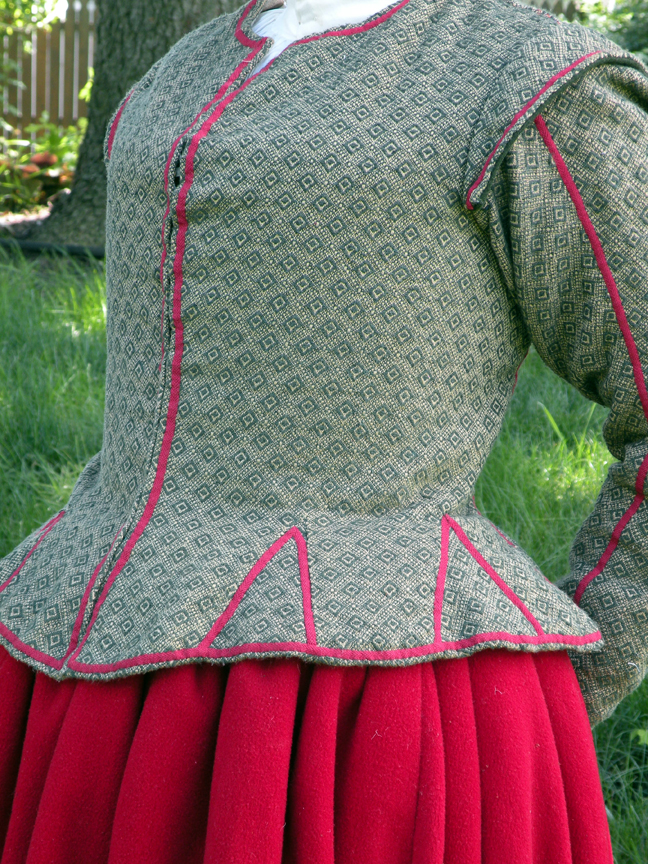

As I get pictures of the clothing I've made put online, I will be adding them to this page. As of now, my wardrobe is relatively scant.
 Item a Grene JAKETT of mixed Linen and Sylke in a diamant pattern, lined with fustian, welted with caddis lace.
Item a PETYCOTE of red brodclothe with frieze to lyne the pleates.
Item a Grene JAKETT of mixed Linen and Sylke in a diamant pattern, lined with fustian, welted with caddis lace.
Item a PETYCOTE of red brodclothe with frieze to lyne the pleates.
This jacket and petticoat are representative of what a fairly well-to-do goodwife would have worn at the turn of the 17th century.
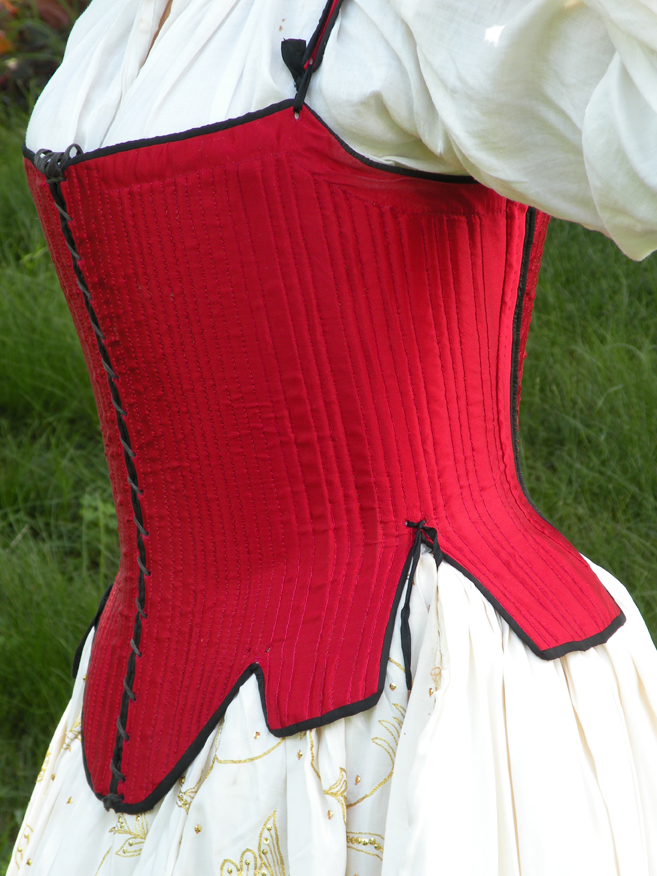 Item a pair of crimsin silke FRENCH BODIES bordered with blak taffatie, with canuas and whall-bone and bent to the same.
Item a pair of crimsin silke FRENCH BODIES bordered with blak taffatie, with canuas and whall-bone and bent to the same.
In the late Elizabethan Era, "French Bodies" were fully boned bodices, frequently with busks, that laced up the front and were meant to be worn underneath outer garments--in other words, corsets or stays.
This corset was made in the style of the Effigy Corset, currently dated to 1602. It has an outer layer of heavy red silk satin, and an inner layer of heavy linen twill. The edge is bound with black silk taffeta, and it is boned with a modern equivalent of "bent grass" (aka size 00 basketweaving reed) and with artificial whalebone.
 Item a PETTICOATE of brown velvet with red vellat guards thereto and a jacket "broidered" with sleve silke of cullors, with small weltes of brown taffetie thereto.
Item a PETTICOATE of brown velvet with red vellat guards thereto and a jacket "broidered" with sleve silke of cullors, with small weltes of brown taffetie thereto.
This is a recreation of an outfit which would have been worn by a gentlewoman of modest means at the end of Elizabeth's reign, around 1600 to 1604. It is a jacket, or "waistcoat", and a separate velvet petticoat skirt. The skirt is cartridge-pleated to a band, and is designed to be worn over a french farthingale--not the vast farthingales worn at court, but a more modest farthingale suitable to the wearer's station. Under the skirt and jacket is a linen "petticoat bodies", a petticoat pleated to a sleeveless bodice. This bodice both supported the petticoat, and supported/flattened the bosom of the woman wearing it. A linen "ruffed partlet" goes with this (though I'm not wearing it in the picture.) A close-fitting white linen smock gathered to a is worn underneath.
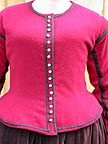 Item a WAISTCOATE of Scarlett bordered with a welt of browne woll with siluer buttons to it.
Item a WAISTCOATE of Scarlett bordered with a welt of browne woll with siluer buttons to it.
This waistcoat is patterned after the one in Arnold's Patterns of Fashion 1560-1620. The material is a heavy red wool, which I dyed scarlet using a recipe I redacted from the 16th century dye book The Plictho.
The lining was a fine, tightly woven linen; the welts were a thin brown wool, and the buttons are reproduction 16th century buttons from Pewter Replicas. The jacket was hand-sewn with black silk and white linen thread. The buttonholes were stitched with red silk.
 Item a DUCHE CLOAKE of black wool with thre guards of black taphata round the edges and guarded chevernewise down the slevis.
Item a DUCHE CLOAKE of black wool with thre guards of black taphata round the edges and guarded chevernewise down the slevis.
The cassock, also termed a "Dutch Cloak" or "Gascoigne Cloak", was a loose, sleeved garment of around hip-length, worn by both men and women during the last half of the 16th century. (More on Cassocks)
This cassock is made of fine black wool, lined with white linen. A set of triple welts, made of black silk taffeta, edge the front, collar, bottom and go up the center back. The sleeves also have welts applied diagonally and down the front and back seams.
Each armescye has a double set of tabs. The armescye is open in the front, to allow the sleeves to be worn or not worn as the climate demands.
 Item A DUBLETT of tawney mockadow, guarded with russet weltes, with a KIRTLE of russet worsted to the same.
Item A DUBLETT of tawney mockadow, guarded with russet weltes, with a KIRTLE of russet worsted to the same.
This outfit would have been worn by a Gentlewoman of modest means in the latter half of the 1580s. The kirtle bodice was patterned after the kirtles in Alcega's Tailor's Pattern Book, the skirt patterned after a petticoat shown in Arnold's Patterns of Fashion. It is made of a wool-cotton blend, and laces up the back side with a matching russet silk ribbon.The fabric is similar to a late 16th-century worsted.
The doublet is made of a tawny brushed cotton twill similar in texture to period mockado. It is decorated with welts of the same russet fabric of which the kirtle is made, and is lined in straw-coloured linen. The buttons are brass. The buttonloops on the sleeves are of waxed linen cord. The points which tie the sleeves to the dublet are of russet silk, tipped with brass bugle beads.
This front-lacing corset is a reproduction of the corset worn by the Queen Elizabeth's effigy, recently dated to 1602. The corset itself is of cream-colored linen. The edges are bound with fine, cream-colored kidskin. Two steel bones going down the front take the place of the original strips of whalebone. The eyelets are bound with heavy linen thread, and the straps attach to the front outer neckline of the corset with similar eyelets. The corset itself is boned with bundles of broomstraw, like the original was. As you can see, this boning gives plenty of support. It also breathes well and stretches to conform to the body.
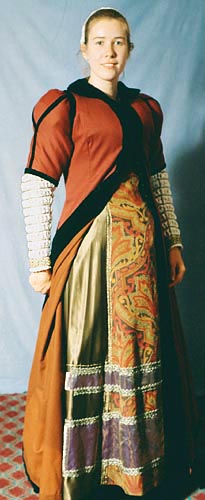 Item a FLAUNDERS GOWNE of russet wool welted and guarded with black vellat.
Item a KYRTLE of green satten with a forepart of russet and gold and browne damask, with two gards of cloth of gold and with sleeves of white cutteworke satin to the same.
Item a FLAUNDERS GOWNE of russet wool welted and guarded with black vellat.
Item a KYRTLE of green satten with a forepart of russet and gold and browne damask, with two gards of cloth of gold and with sleeves of white cutteworke satin to the same.
The gown is made of russet wool/cotton in the style of the gowns worn by London genglewomen in DeHeere's sketch from 1570, interlined with a layer of flannel to give it body and lined with brown brushed cotton twill. The collar is pad-stitched, and can be worn flat or worn up.
The undergown is a kirtle based very closely on the loose kirtle in Janet Arnold's Patterns of fashion. The kirtle is of olive silk satin, with a forepart of a russet/green/gold/brown brocade. it is lined in a gold-colored linen, with the bottom two feet lined in brown taffeta, like the original garment (ivory taffeta). The guards are the same size and placement as on the original.
 Item a SERVAUNT-WOMANS GOWNE of the Flemisshe facion with tawney bayes guarded with murrey wool with a redde petticoate and sleeues of green wool to the same, wyth twoo partelets one white linnen one black wool to the same.
Item a SERVAUNT-WOMANS GOWNE of the Flemisshe facion with tawney bayes guarded with murrey wool with a redde petticoate and sleeues of green wool to the same, wyth twoo partelets one white linnen one black wool to the same.
This gown is based on that worn by a marketwoman or servant in 1560s Flanders. It laces across a sleeveless petticoat of red linen (which laces up the back) and has green woolen sleeves pinned to the gown shoulder straps. A close-fitting white smock is worn underneath. Two partlets, one white linen and one black wool, are worn over the gown. A caul is worn over the hair, and a straw hat over the caul.
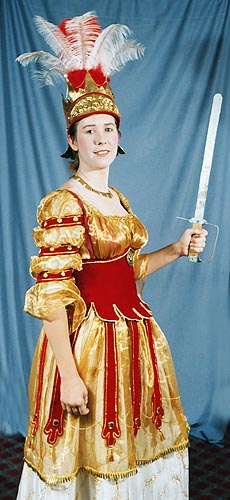 Item a MASQUER'S GOWNE for Penthesilea, Queene of the Amazones
Item a MASQUER'S GOWNE for Penthesilea, Queene of the Amazones